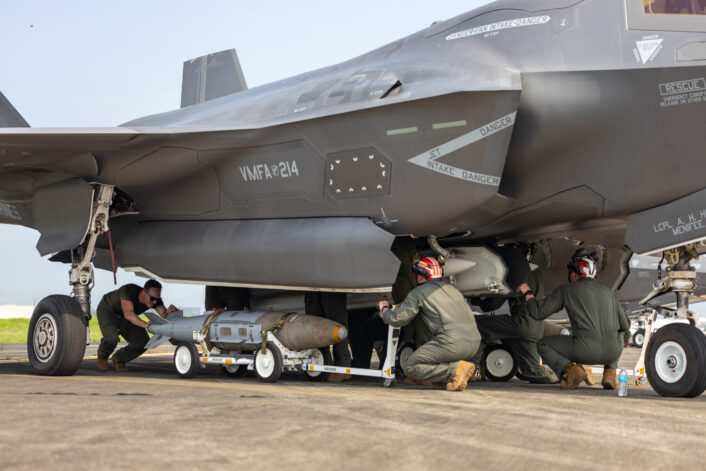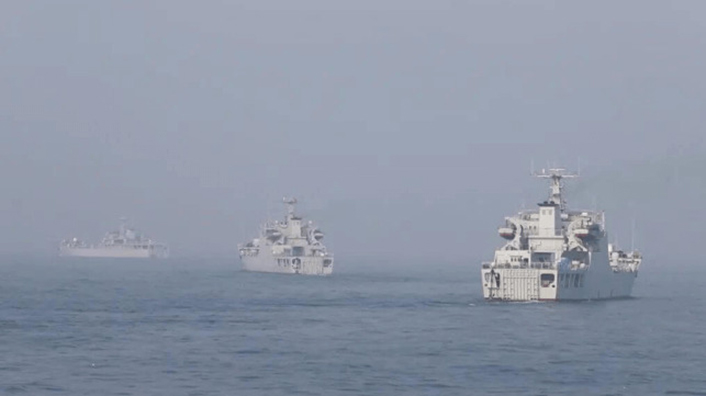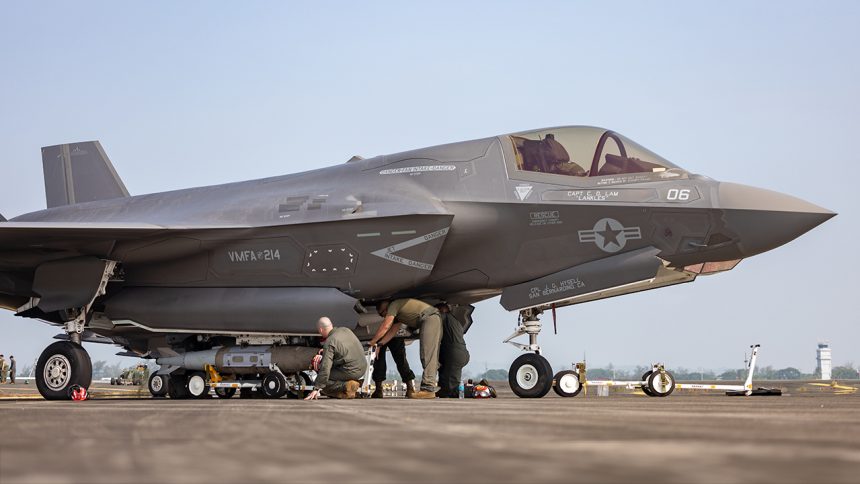Philippine unmanned aerial reconnaissance assets provided critical visual information, with the intelligence relayed to Philippine artillery and US F-35Bs for striking the floating targets.
The United States and the Philippines held live-fire exercises last week in the SCS (South China Sea), amid Beijing’s increasing friction with the Philippines over conflicting maritime claims.
The exercise between the US and Philippines was defined as the “first-of-its-kind”, involving US Marine Corps F-35B Lightning II jets dropping bombs on “floating targets,” as per USNI News. Official press releases mention that these drills took place between Jun. 15 and 21, with four F-35Bs dropping seven GBU-32 JDAM (Joint Direct Attack Munition) bombs on floating targets off the coast of western Luzon.
The latest reports mention the PLA Navy also held live-fire exercises using small amphibious ships on Jun. 19, 2024. The Chinese exercise seems to be an extension of the drills that Global Times previously reported on Mar. 17, 2024, which involved smaller amphibious “tank landing ships” and also included a live-fire element.
F-35Bs bomb floating targets
The USMC revealed, on Jun. 24, that the MASA (Marine Aviation Support Activity) was held on Jun. 15, with a LLFX (Littoral Live-Fire Exercise) component. The acitvity “tested the combined US-Philippine capability to synchronize multiple aviation and ground-based assets to conduct controlled strikes in Philippine territorial waters to simulate a coastal defense scenario against an adversary.”
In total, three 105 mm howitzers from the 4th Marine Brigade of the Philippine Marine Corps and four U.S. Marine Corps F-35B Lightning II aircraft with VMFA 214 used live ordnance during the event on targets crafted by local Philippine contractors “to simulate vessels.”
Using intelligence from the Philippine Navy and Air Force drones, Philippine’s and US personnel relayed orders to a C-130 orbiting near the exercise area, which hosted the aviation command element. This element then passed the necessary targeting information to the four F-35Bs from the Marine Fighter Attack Squadron (VMFA) 214 “Black Sheep”.

Once the F-35Bs found their targets, this information was relayed back to the combined command center. The F-35Bs struck their targets with precision, landing all seven GBU-32 bombs on the ocean targets positioned three nautical miles off the coast of Zambales, mentioned the USMC.
Four F-35Bs of VMFA-214 “Black Sheep” came to the Philippines for a maritime strike exercise off Western Luzon during Marine Aviation Support Activity 2024. The drill focused on enhancing 🇵🇭🇺🇸 command and control capabilities in a territorial defense scenario. pic.twitter.com/hDxdWC1AmX
— Aaron-Matthew Lariosa (@Aaron_MatthewIL) June 15, 2024
“MASA is basically designed to enhance capabilities, develop interoperability, and enhance cooperation in the use of aviation assets to support Marine-Air-Ground operations,” said Brig. Gen Robert Brodie in the USMC press release. These drills are part of the even larger maneuvers which encompassed air, sea, and land domains from the islands of Palawan to Batan with elements of the I and III MEF (Marine Expeditionary Forces).
The Commandant of the Philippine Marine Corps, Brig. Gen. Romea T. Racadio, ws also quoted saying “MASA is a magnificent opportunity for us to bring our aviation assets to provide mobility, reconnaissance, and the ability to get into areas that we normally can’t see into.”
Chinese Drills
The SCMP (South China Morning Post), quoting CCTV, said the “naval task force comprising landing ships Danxiashan, Laotieshan and Lushan conducted an all-weather full-course combat exercise over four days in the SCS.” The drills were carried out “recently,” but it was not specified when they took place.
While the fleet also carried out “air-defence training” where “multiple rounds” were fired on “‘enemy drones,’” the goal was to “test the Chinese navy’s emergency response and coordinated combat capabilities.” This suggests a combined arms maneuver, featuring elements of naval aviation and naval vessels and possibly PLA Air Force and PLA Navy’s unmanned and manned reconnaissance assets.

Further reports said that Danxiashan, Laotieshan and Lushan “carried out a four-day combat drill at an undisclosed location in the South China Sea.” “The drills focused on search and rescue, live fire, damage control, ship-to-ship mooring, smokescreens, and anti-drone air defense operations – a modern addition reflecting the recent evolution of unmanned aviation.”
While the Danxiashan figures in all reports, Global Times identifies the other landing ships as the Daiyunshan and the Wanyangshan. CCTV however mentions only the Danxiashan. CCTVs footage last week showed crews on board the Danxiashan firing heavy caliber anti-aircraft guns on what appear to be target drones, and quoted officer Zhang Jianbin who said it was “difficult shooting at the target with little response time,” forcing crews to “constantly adjust shooting angles.”
The “all-weather multi-subject actual combat drill” focused on “anti-drone exercises, driving the enemy drone away from suppressive fire and quickly shift shooting position under the cover of smoke.” The aim was to improve crew proficiency with “continuous and non-stop training at sea.”
The smaller, older generation landing ships deploy small numbers of troops or armored vehicles directly onto the beach. Danxiashan is a Type 072 tank landing ship, a Cold War-era design with a capacity to deliver up to 10 tanks. They could be used for direct amphibious landings on reefs, atolls and other contested features in the Spratly Islands, giving China the ability to quickly seize undefended land features in Philippine waters.
Global Times also said that, between the larger Type 071 and the Type 075 amphibious assault ships or LHDs (Landing Helicopter Docks), “the smaller Type 072 tank landing ships take advantage of their large numbers and higher flexibility.”
“Unlike their larger successors that release landing forces remotely from ashore, Type 072 offload vehicles, troops, and cargo directly on shore.” Type 072’s are considered “particularly useful” in asserting China’s “maritime rights over islands and reefs in the SCS.”









